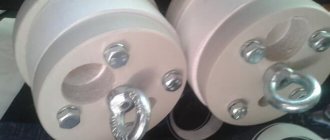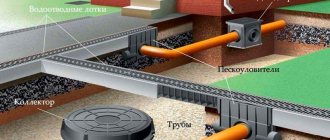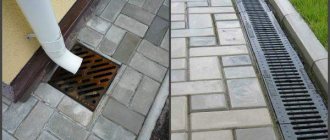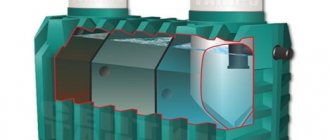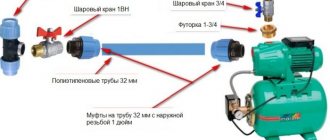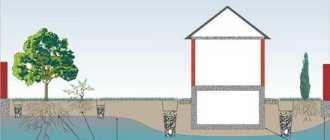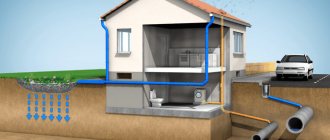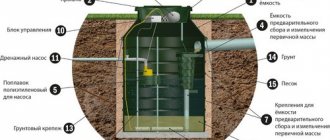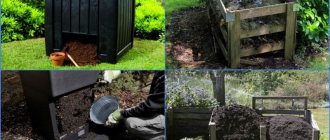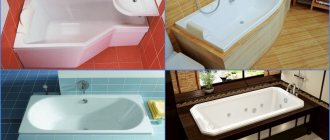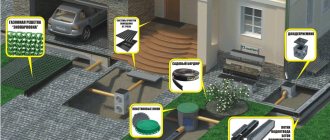Why is low tide needed?
The installation of ebb tides on the roof has several purposes:
- strengthening roof rigidity;
- increasing resistance to temperature changes and precipitation;
- aesthetic appeal;
- protecting walls from large amounts of water;
- additional roof protection;
- closing joints between materials.
Organizing a water drainage system is not difficult if it is carried out in accordance with the requirements for installation and selection of material. Currently, there is simply a huge range of systems that allows you to assemble a kit in accordance with your requirements for color and other characteristics.
Basic principles of water drainage
To summarize, it is worth paying attention to the basic principles and concepts of water drainage from flat roofs. The main elements are the roof funnels themselves, which already direct water into the drain pipes, from where it is discharged into the sewer system, the ground, or special containers provided for this purpose. Pipes, in turn, can be located outside the building or inside.
To carry out a problem-free drainage process, it is necessary to place the funnel at the lowest point of the roof, not forgetting about the slope, the minimum of which should be within 3%.
There should be several funnels, in case the main one is blocked, and they should all be connected to one pipe. It is worth installing them every 25 meters, not forgetting about the emergency low tide, in case the main system cannot cope with an excessive amount of water.
They should be selected depending on the design and purpose of the roof, as well as the level of insulation.
It is important to decide whether the sewer pipes will be located outside or inside. It is preferable to choose external pipes, since they are easier to operate, given that they are easy to clean or repair. The only drawback is the aesthetic point. However, the appearance of the pipes does not spoil the appearance of the building so much.
Pipes installed indoors have many more disadvantages. They are difficult to access, and in the event of a leak, fungus will inevitably appear.
It is worth considering freezing in areas of the drainage system, which can lead to blockage of pipes. To avoid this, you can install heated funnels.
If we take into account all the nuances described above, a flat roof can not only delight with its unusual appearance and perform additional functions, but also remain dry all year round, regardless of the amount of precipitation in any weather!
Material of manufacture: advantages and disadvantages of each
Rain ebbs under the roof can be:
- galvanized;
- copper;
- aluminum;
- titanium-zinc;
- plastic.
Rain flashings under the roof can be made from various materials Source m.azh.kz
In rare cases, flashings can be made from stone or ceramics. Their low demand is due to the complexity of production and very high price. There are also drainage structures made of complex alloys, which usually have a higher cost.
For your information! Metal structures are much noisier when it rains than plastic ones. Sometimes their surface is pre-treated with polymers for better sound dampening.
Galvanized structures
Alloy steel has a thickness of about 1 mm and is considered a good option for making drainage systems. The affordable price is combined with the durability of the products and their resistance to corrosion.
Roof flashing made of galvanized material Source alp-ur.ru
A special feature of the installation of such structures is the increased reliability of the fasteners due to the fact that the metal has an impressive weight. It is important to prevent damage to the coating, as this will begin the oxidation process as a result of contact with moisture, which will lead to the destruction of the metal.
Copper structures
This material is one of the most expensive castings to manufacture, but at the same time durable. Not every type of copper is resistant to corrosion processes, only oxidized and brass-plated ones.
Roof flashing made of copper material Source pravapisanie.ru
Copper casting also has a lot of weight, so it requires very reliable fastening. The disadvantage of using this material is its high price.
Aluminum structures
Aluminum is a lightweight material with a thickness of up to 1 mm and is quite easy to install. It is lightweight, but is susceptible to oxidation when in contact with water.
Aluminum roof flashing Source obustroeno.com
Advice! To prevent structural damage, the surface of the gutters must be coated with a special protective compound.
Titanium-zinc structures
This is a durable, expensive and very durable material. It has a long service life. The zinc content in such an alloy exceeds 99%. This is a plastic material with good anti-corrosion properties.
The service life of such a system is more than 100 years. Among the advantages are a presentable appearance and environmental friendliness, no need for additional painting or other processing. The downside is the high price.
Plastic structures
Plastic roof drains are considered the most popular. They are quickly installed, light weight, affordable price and good strength. At the same time, they do not fade and can serve for a long time. A large selection of colors and models allows you to choose gutters in a suitable design. The disadvantage of plastic is that it is brittle at low temperatures.
Plastic ebb for water Source goldkryshi.ru
See also: Catalog of companies that specialize in roof repair and design.
Gutter maintenance
Timely and correct maintenance of the drainage system will increase the efficiency of the system and avoid costly restoration repairs in the event of an accident.
One of the risk factors is clogging the system with debris, including fallen leaves. To prevent them from getting into the gutters, it is recommended to install upper protective grilles.
Grilles protect gutters from debris
Important: However, twice a year, in autumn and spring, it is recommended to carry out a thorough cleaning of the drainage system, since the system for draining rainwater from the roof can also become clogged due to the ingress of small particles.
The easiest way to clean communications is with water pressure. This can be done at home using a regular flexible hose. After washing, you need to remove debris and dirt from the grates.
Even if you find dirt stuck to the surface of the gutter, you should not use sharp objects to remove it or scrape off any stains or formations that have appeared. In this case, there is a high probability of damage to the coating (polymer or galvanized), which will inevitably lead to corrosion of the area.
Problem areas (joints, corners, connections of gutters with funnels, etc.) require special attention when cleaning. In these places, the flow speed changes, which increases the risk of traffic jams. The unevenness of the surface at the seams also contributes to its increase.
If the installation of a roof drain with your own hands is done with high quality, the diagram is accurately calculated in advance, and during operation the home owners do not neglect the need to carry out preventive measures, the durability of the system will be maximum. In this case, the drain will work effectively throughout its entire service life, requiring virtually no repairs.
And the good condition and performance of the drainage system can largely affect the technical condition and durability of the building itself.
Choosing a gutter shape
The gutters through which water flows can be:
- rectangular;
- rounded;
- triangular.
It is into the gutters that water enters from the roof surface, which is then discharged in the desired direction. Without them installed, drainage will not flow smoothly and water can cause damage to your home.
The gutters through which water flows can be of various shapes Source staltd.ru
The shape of the gutter plays not only an aesthetic role. It depends on how well the water flows.
Advice! Experienced craftsmen consider a rounded shape to be more functional. It is less likely to cause blockages as a result of debris, dry leaves and dust. Therefore, you will have to clean it less often.
Drainpipes
Vertical drainpipes drain water from low tides. Usually they are installed on the house 5 or 6 meters apart. The material of their manufacture and color must match the tides under the roof. If the house has a complex structure and shape, then even more dense installation of drainpipes is necessary - at least at each corner of the building.
Water flows through the drainpipe under high pressure. To compensate for the pressure, a lower drain is made in the shape of an elbow.
For your information! The distance from the lower drain elbow to the ground should be no more than 0.5 meters.
Vertical pipes drain water from low tides Source obustroeno.com
It is important to choose the right location for the drain pipe. The water that will drain through it should not flood the foundation or flood the pedestrian part of the sidewalk. The best option for draining water would be a storm drain, a specially made depression in the sidewalk for drainage.
Sometimes, to collect rainwater, drainage is arranged in a barrel or tank. In this case, you should take into account in advance its volume and the fact that the container will have to be emptied periodically.
Gutter heating
Installing heated roof ebbs with your own hands will require additional effort and strict adherence to safety regulations, but such labor costs are fully justified by the increased efficiency and safety of the system. In this case, the drains are protected from the formation of ice, freezing, and the formation of traffic jams.
There are two possible drainage heating schemes:
- Internal heating involves laying a heating cable along the bottom of the gutters.
- The external scheme involves installing the heater on the lower part of the roof slope.
Internal heating of gutters
Obviously, to heat the drain, only special waterproof cables are used.
What to look for when purchasing and installing
Even if you choose a good material, poor installation can ruin everything.
It is necessary to pay special attention to the installation of the drip sill Source ms.decorexpro.com
In order for roof drainage systems to serve for many years, you must adhere to the following rules :
- The size of the gutter should correspond to the area of the roof slope. The larger it is, the larger the diameter of the gutter should be. Otherwise, the structure may not cope with water drainage during heavy rain or intense snow melting.
- Fittings and all materials for fastening must match the design in size and material.
- When ordering flashings, you must add a margin of 15% or slightly less to the required length for installation of joints.
- A drip cap will prevent splashing. It slides under the roof and its bottom fits into the gutter.
- Each slope is usually equipped with two drainage pipes.
- A sufficient number of drainpipes are required
- The ebb tides should be a few centimeters . Otherwise, they may be damaged when the snow melts.
- In most cases, the color of the tides The approach to external design depends on whether this element should serve as a decorative element or whether it should be practically invisible.
The color of the ebb can be matched to the color of the roof Source coh.noribeta.ru.net
DIY installation
For work you will need: a pencil or pen, take a tape measure and a square, you also need metal scissors, and a drill with attachments. Grab the ebb, side plugs, a dozen self-tapping screws, mounting foam, a stepladder, a file, a hammer, and some sealant. And don’t forget a good mood - this is very important in work. Be careful and careful when installing.
To install a low tide, it is necessary to maintain the required slope of the gutter so that there is proper flow of water. The inclination of the gutter should be approximately 3 mm per 1 m.
Pull the string to ensure the correct inclination of the ebb, and install the fasteners along it. Place the rubber seal in the middle of the ebb and bracket for better protection and good fastening. Before installing the flashing, install waterproofing and vapor barrier.
